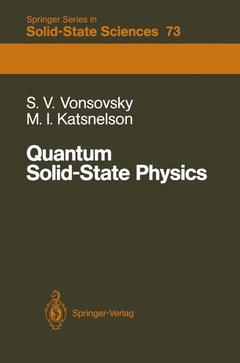Description
Quantum Solid-State Physics, Softcover reprint of the original 1st ed. 1989
Coll. Springer Series in Solid-State Sciences, Vol. 73
Authors: Vonsovsky Serghey V., Katsnelson Mikhail I.
Language: French
Subject for Quantum Solid-State Physics:
52.74 €
In Print (Delivery period: 15 days).
Add to cart
Publication date: 05-2012
505 p. · 15.5x23.5 cm · Paperback
505 p. · 15.5x23.5 cm · Paperback
Description
/li>Contents
/li>
This book treats the major problems of the quantum physics of solids, ranging from fundamental concepts to topical issues. Rather than use a deductive method of exposition, the authors consider and analyze simple empirically established properties of solids and employ more complicated models only as the need arises. Detailed treatment is given of classical problems such as chemical bonding in crystals, the one-dimensional Schrödinger equation with a periodic potential, the metal-insulator criterion, and the quantum theory of band electron motion in external fields. Consideration is also given to topical problems such as neutron scattering by the crystal lattice, plasma and Fermi liquid effects, the theory of disordered systems, and the polaron. The reader is expected to know only the fundamentals of quantum mechanics and statistical physics. Compared with the Russian edition (Nauka, Moscow 1983), the book has been substantially revised and enlarged, new sections have been written and recent results have been incorporated.
1. Introduction. General Properties of the Solid State of Matter.- 1.1 General Thermodynamic Description of the Solid State.- 1.2 Crystal Structure of Solids.- 1.3 Reciprocal Lattice.- 1.4 Examples of Simple Crystal Structures.- 1.5 Experimental Techniques for Determining the Periodic Atomic Structure of Solids.- 1.6 Qualitative Concepts of the Electronic and Nuclear Crystal Structure.- 1.7 Fundamental Concepts of the Chemical Bonding in Solids.- 1.8 Types of Crystalline Solids.- 1.9 Formulation of the General Quantum-Mechanical Problem of the Crystal.- 1.10 Properties of Disordered Condensed Systems.- 2. Dynamic Properties of the Crystal Lattice.- 2.1 The Dynamics of the Ionic Lattice.- 2.2 The Specific-Heat Capacity of the Lattice.- 2.3 Allowance for Anharmonic Terms.- 2.4 Localization of Phonons on Point Defects.- 2.5 Heat Capacity of Glasses at Low Temperatures.- 2.6 High-Frequency Permittivity of Ionic Crystals.- 2.7 Lattice Scattering and the Mössbauer Effect.- 2.8 Conclusion.- 3. Simple Metals: The Free Electron-Gas Model.- 3.1 Types of Metals.- 3.2 Physical Properties of the Metallic State. Conduction Electrons.- 3.3 Classical Conduction-Electron Theory (Drude-Lorentz Theory).- 3.4 Itinerant Electron Theory According to Frenkel.- 3.5 Application of Fermi-Dirac Quantum Statistics to the Conduction-Electron Gas.- 3.6 Transport Phenomena.- 3.7 High-Frequency Properties.- 3.8 Conclusions.- 4. Band Theory.- 4.1 Preliminary Observations and the One-Dimensional Model.- 4.2 General Theory of the Electron Motion in a Three-Dimensional Crystal.- 4.3 Nearly-Free-Electron Approximation.- 4.4 Effect of an Electric Field on Electronic States.- 4.5 The Metal-Semiconductor Criterion.- 4.6 Computing the Electron Energy Spectrum of Crystals.- 4.7 Band Electrons in a Magnetic Field.- 4.8 Impurity States.- 4.9 The Electronic Structure of Disordered Systems.- 4.10 Conclusion. The Role of Many-Particle Effects.- 5. Many-Particle Effects.- 5.1 Plasma Phenomena. Screening.- 5.2 TheFermi-Liquid Theory.- 5.3 Electron-Phonon Interaction.- 5.4 Superconductivity.- 5.5 Excitons.- 5.6 Transition Metals and Their Compounds.- 5.7 Anderson’s Orthogonality Catastrophe.- 5.8 Conclusion.- Addenda (Recent Developments).- References.
© 2024 LAVOISIER S.A.S.

